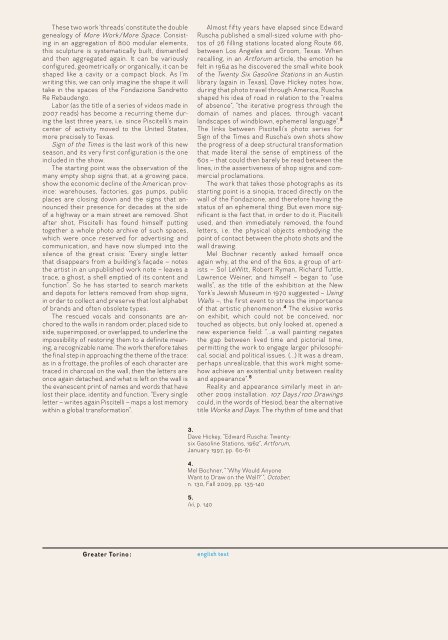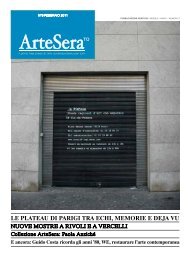Download Catalogue - Paola Anziché
Download Catalogue - Paola Anziché
Download Catalogue - Paola Anziché
Create successful ePaper yourself
Turn your PDF publications into a flip-book with our unique Google optimized e-Paper software.
These two work ‘threads’ constitute the double<br />
genealogy of More Work / More Space. Consisting<br />
in an aggregation of 800 modular elements,<br />
this sculpture is systematically built, dismantled<br />
and then aggregated again. It can be variously<br />
configured, geometrically or organically, it can be<br />
shaped like a cavity or a compact block. As I’m<br />
writing this, we can only imagine the shape it will<br />
take in the spaces of the Fondazione Sandretto<br />
Re Rebaudengo.<br />
Labor (as the title of a series of videos made in<br />
2007 reads) has become a recurring theme during<br />
the last three years, i.e. since Piscitelli’s main<br />
center of activity moved to the United States,<br />
more precisely to Texas.<br />
Sign of the Times is the last work of this new<br />
season, and its very first configuration is the one<br />
included in the show.<br />
The starting point was the observation of the<br />
many empty shop signs that, at a growing pace,<br />
show the economic decline of the American province:<br />
warehouses, factories, gas pumps, public<br />
places are closing down and the signs that announced<br />
their presence for decades at the side<br />
of a highway or a main street are removed. Shot<br />
after shot, Piscitelli has found himself putting<br />
together a whole photo archive of such spaces,<br />
which were once reserved for advertising and<br />
communication, and have now slumped into the<br />
silence of the great crisis: “Every single letter<br />
that disappears from a building’s façade – notes<br />
the artist in an unpublished work note – leaves a<br />
trace, a ghost, a shell emptied of its content and<br />
function”. So he has started to search markets<br />
and depots for letters removed from shop signs,<br />
in order to collect and preserve that lost alphabet<br />
of brands and often obsolete types.<br />
The rescued vocals and consonants are anchored<br />
to the walls in random order, placed side to<br />
side, superimposed, or overlapped, to underline the<br />
impossibility of restoring them to a definite meaning,<br />
a recognizable name. The work therefore takes<br />
the final step in approaching the theme of the trace:<br />
as in a frottage, the profiles of each character are<br />
traced in charcoal on the wall, then the letters are<br />
once again detached, and what is left on the wall is<br />
the evanescent print of names and words that have<br />
lost their place, identity and function. “Every single<br />
letter – writes again Piscitelli – maps a lost memory<br />
within a global transformation”.<br />
Greater Torino :<br />
Almost fifty years have elapsed since Edward<br />
Ruscha published a small-sized volume with photos<br />
of 26 filling stations located along Route 66,<br />
between Los Angeles and Groom, Texas. When<br />
recalling, in an Artforum article, the emotion he<br />
felt in 1964 as he discovered the small white book<br />
of the Twenty Six Gasoline Stations in an Austin<br />
library (again in Texas), Dave Hickey notes how,<br />
during that photo travel through America, Ruscha<br />
shaped his idea of road in relation to the “realms<br />
of absence”, “the iterative progress through the<br />
domain of names and places, through vacant<br />
landscapes of windblown, ephemeral language”. 3<br />
The links between Piscitelli’s photo series for<br />
Sign of the Times and Ruscha’s own shots show<br />
the progress of a deep structural transformation<br />
that made literal the sense of emptiness of the<br />
60s – that could then barely be read between the<br />
lines, in the assertiveness of shop signs and commercial<br />
proclamations.<br />
The work that takes those photographs as its<br />
starting point is a sinopia, traced directly on the<br />
wall of the Fondazione, and therefore having the<br />
status of an ephemeral thing. But even more significant<br />
is the fact that, in order to do it, Piscitelli<br />
used, and then immediately removed, the found<br />
letters, i.e. the physical objects embodying the<br />
point of contact between the photo shots and the<br />
wall drawing.<br />
Mel Bochner recently asked himself once<br />
again why, at the end of the 60s, a group of artists<br />
– Sol LeWitt, Robert Ryman, Richard Tuttle,<br />
Lawrence Weiner, and himself – began to “use<br />
walls”, as the title of the exhibition at the New<br />
York’s Jewish Museum in 1970 suggested – Using<br />
Walls –, the first event to stress the importance<br />
of that artistic phenomenon. 4 The elusive works<br />
on exhibit, which could not be conceived, nor<br />
touched as objects, but only looked at, opened a<br />
new experience field: “…a wall painting negates<br />
the gap between lived time and pictorial time,<br />
permitting the work to engage larger philosophical,<br />
social, and political issues. (…) It was a dream,<br />
perhaps unrealizable, that this work might somehow<br />
achieve an existential unity between reality<br />
and appearance”. 5<br />
Reality and appearance similarly meet in another<br />
2009 installation. 107 Days / 100 Drawings<br />
could, in the words of Hesiod, bear the alternative<br />
title Works and Days. The rhythm of time and that<br />
3.<br />
Dave Hickey, “Edward Ruscha: Twentysix<br />
Gasoline Stations, 1962”, Artforum,<br />
January 1997, pp. 60-61<br />
4.<br />
Mel Bochner, “ ‘Why Would Anyone<br />
Want to Draw on the Wall?’ ”, October,<br />
n. 130, Fall 2009, pp. 135-140<br />
5.<br />
Ivi, p. 140<br />
english text



